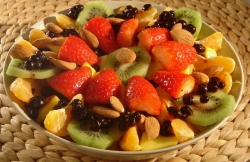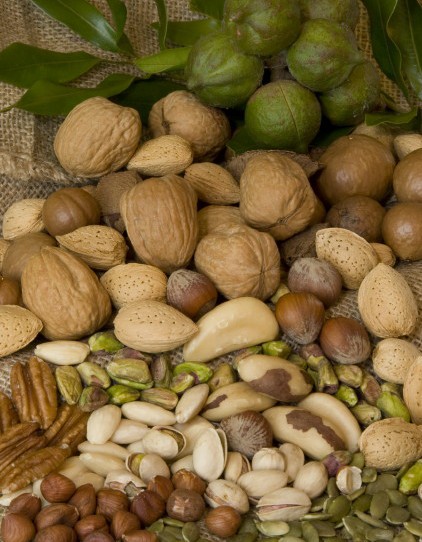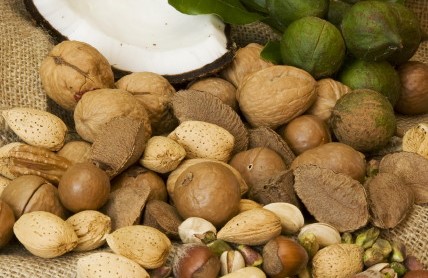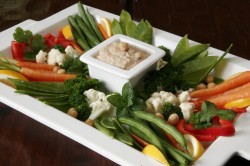Kick Start Your Day
Breakfast Options
Breakfast Recipes

Are you a breakfast lover who likes to get ready for a busy day with a good morning meal? Or does breakfast come up short when you’re pressed for time or not hungry in the morning? Either way, we can help you to make the right food choices so that you’ll have energy all day long.
A well-balanced, nutritious breakfast doesn’t have to be expensive, complicated or time-consuming. Here’s what you can expect from eating a breakfast that’s comprised of the right food choices: increased energy, higher concentration levels and better weight control. There’s significant evidence that eating breakfast, even a small one, will literally kick start your metabolism and help you burn more calories during the rest of the day(1)(2).
In addition, instead of the traditional big three, eating five to six small meals a day is recommended because smaller meals put considerably less stress on the digestive system. This makes detoxification easier and will keep you more consistently energized, both physically and mentally, since the calories are more evenly processed and distributed throughout the day.
We think you will agree that the most desirable characteristics of a good breakfast should be that it’s light, tasty, nutritious, long-lasting and easy to digest. You may wonder how light and long-lasting go together. Well, it has a lot to do with the glycemic index, also known as the
GI(3). High-glycemic foods, like most starches, for example, toast, bagels, donuts, muffins and most boxed cereals, provoke spikes in the blood sugar level, especially if they make up most of your meals. This can give you a temporary “high” followed by a low as the blood sugar level falls below normal. This creates fatigue and low levels of concentration. High-GI foods cause increased insulin production, which removes the unneeded sugar, often too much, from your bloodstream and stores it as fat. This is known as a “post-sugar crash.” Your brain runs on sugar, and to do a great job at work, at home, in school or while you’re driving, you want to make sure that the flow of that fuel pipeline (your blood sugar) is just right—not too high, not too low—all day long. If you are particularly active, maybe run in the morning, and want that toast, you can lower the GI by adding some good fat (more on this later).
Counteracting tiredness with stimulants like caffeine is the wrong answer. Stimulants cause an increase in cortisol production, which is the same stimulant the body uses for the flight-or-fight response. If this fuel isn’t used, it’s removed and leaves you less energetic than before. This too often leads to that next cup of coffee, and the cycle continues. So what can you do? Solve this problem of being tired by making the right food choices. Certain foods like fruits, yogurt and oats fulfill all the necessary requirements to keep you fit and energized throughout the day. How does oatmeal or muesli, fruit and yogurt, or a smoothie sound to you? These and many more options are available to give you the best start to your day.
If you find it difficult to get up early or you just don’t feel like eating first thing in the morning, you can still maintain healthy breakfast habits. There are easy-to-prepare breakfasts or even ways to prepare your breakfast the night before so it’s ready to go the following morning. We hope this doesn’t sound too bossy, but there’s really no excuse for not eating a good breakfast. Better nutrition can make you feel better, and enable you to get up easier in the future.
Breakfast Options
Uta is a big believer in the power of a good breakfast. Depending on her morning activity level, she follows one of these variations:

First thing: Make sure to be well hydrated before you eat anything in the morning. We recommend drinking one to two glasses of water right after getting up. If you like, add a little fresh squeezed lemon juice to your water.
Before hard physical tasks:
1st option: Tea, half a peeled apple or banana and Oatmeal (see recipe below). Oatmeal is easier to digest than muesli. Also, we prefer to peel the apple because the peel is hard to digest and may contain chemical residues, especially if it’s not organic.
2nd option: Whole grain bread (toast), almond or other raw nut butter, not peanut, and naturally sweetened jam of your choice. The “good” fat from the nut butter lowers the GI.
Before gentle or moderately physical tasks: Tea, half a peeled apple, Muesli (see recipe below) or yogurt with lots of fruit.
Before challenges that require brainpower: Tea and Fit-Yogurt (see recipe below). Uta usually makes hers with low-fat soy yogurt.
Breakfast on the go: A big glass of water as always, then Uta slips an apple, banana, muesli bar and a little soy milk carton into her bag and heads out the door.
When choosing a muesli bar, make sure that oats are first in the listed ingredients. Check that it doesn’t contain bad fats and/or food additives. We like Odwalla.
When feeling lazy: Coffee and a cheese Danish (just kidding, of course). Two slices sweet, nutty bread like a walnut-cranberry bread, which Uta loves, thinly spread with almond butter and topped with soy cheese and (don’t be scared by this) a nice high-quality, naturally sweetened jam. Give it a try—you’ll be delightfully surprised.
Breakfast Recipes
Oatmeal (porridge): If you like, save morning prep time by cooking two or three days’ worth at once. To make this a breakfast-on-the-go, heat it up, pour it into a thermos, stick it in a bag along with an apple and head out the door.
In the evening, heat desired amount of steel-cut oats with two-thirds of the called-for amount of water. Remove from heat, add a handful of washed raisins and let the mixture cool. In the morning, dilute with water, fat-free milk or soy milk to taste, and heat it just until hot. For each serving, stir in a teaspoon of ground flax seed, a good provider of omega-3 fatty acid(4). Uta accompanies this with green tea and half an apple.
Preparation tip: If you chop the raisins in half, the oatmeal tastes sweeter.
Slimming tip: Drink more green tea, eat a little less oatmeal and eat more apples.
Consumer suggestion: Use organic flax seeds and oats, if possible. Also, instant oatmeal is okay if you like the taste and texture, but because it’s more processed, it also has a higher GI. If you have the time, go with the regular version. If time is an issue, go with instant, which can be quickly and easily prepared in the morning.
Muesli: There are many ways to refine this recipe—try adding chopped raw almonds, walnuts and/or hazelnuts, gently toasted sesame seed, or sliced bananas (better to put in fresh in the morning). If you make a big dish of this and leave it in the fridge, you’ll have food for quite a few days. As with oatmeal, you can start by using water only, and then, in the morning, add soy milk to thin it out.
In the evening, in a large bowl put steel-cut oat flakes, a handful of washed dried fruits (raisins, currants, apricots, etc.) water and soy milk in equal proportions. Leave the mixture to soak overnight in the refrigerator. In the morning, take out the amount you want, stir in a teaspoonful of finely ground flax seed plus between half and a whole grated, peeled apple and/or banana. (Of course, you could also simply eat the apple as is, with the muesli.)
Slimming tip: Drink more green tea, have less muesli and more apple, and no nuts.
Consumer suggestion: Use plain soy milk, as other types such as vanilla may contain a lot of sugar. Of course, if weight isn’t an issue, go for it.
General nutritional guideline: Muesli is harder to digest than oatmeal. It contains more fat, takes longer to digest, and this may cause problems when training. To cut fat, use water rather than soy milk, and eliminate the added nuts and seeds.
Uta usually doesn’t eat big portions of muesli, so she’ll have at least half an apple with it. If you need to eat more, try adding more apple first before eating more muesli. But we’re all unique in our energy needs and expenditure, and you’ll find the mixture that’s right for you.
Some people like yogurt in their muesli. Although yogurt is more easily digested than milk and most other high-protein foods and therefore this seems to be a good idea, Uta doesn’t recommend muesli with large amounts of yogurt. Because of the protein content in yogurt, mixing it with relatively high amounts of starches contained in the muesli, makes digestion more difficult. That’s why we suggest oatmeal and muesli be prepared primarily with water and just a little soy milk, added at the end. We leave it up to you to experiment.
Here’s another suggestion: Some people who like muesli/oatmeal the best add a little whey protein to it, which is very easy to digest. Another option would be to use fermented soy protein powder, mix it with water to give it a milky consistence and add it. Please remember, a small amount does it. Also, you can have a yogurt or smoothie later as a snack or make it the main part of your breakfast.
Fit-Yogurt: Preparation time for our “Fit-Yogurt” is only two minutes. This yogurt recipe is really healthful, and is good not only before a day at the office or studying, but as a snack at any time. In case you have a higher than normal protein need, you can add some whey or fermented soy protein powder. Doing so, of course, increases the protein content of the yogurt, but note that fermented soy protein and especially whey are not only of high quality, but also easily digestible.
For each serving: Put as much fat-free organic yogurt as you want in a big dish. Stir in a teaspoon of finely ground flaxseeds and add good amounts of raw fruit, such as berries, grapes and/or chopped orange, pineapple, kiwi and mango.
General nutritional guideline: The correct amount of total protein for each main meal is 20 grams for a small person and 30 to 40 grams for a very big person or bodybuilder. Such amounts are easily handled. Digestive problems are caused less by the amount of protein as by the simultaneous intake of large portions of starch and/or unhealthy fat, not to mention sugar-laden desserts. Yogurt and fruit are a good combination.
Smoothie: A quick, tasty alternative to start your day! They only take a few minutes to prepare so are always great for a breakfast on the run. Making smoothies is very simple, and the ingredients are similar to those in Fit-Yogurt.
For each serving: Put 8 ounces of low-fat or fat-free milk or light soy milk in a blender. Add whey protein, in same amounts as those suggested above, a teaspoon of ground flaxseed and fruit. For a slightly thicker and more refreshing drink add some ice cubes.
Slimming tip: Replace some of the milk with water and use more fruit, especially berries, oranges, pineapple, mango.
Reading Suggestions:
- “Berries: Vibrant Flavors Bursting with Nutrition“
- “Uta’s Summary for Your Marathon Preparation. Part III: Nutrition“
(1) Wyatt HR, Grunwald GK, Mosca CL, Wing RR and Hill JO (2002): Long-Term Weight Loss and Breakfast in Subjects in the National Weight Control Registry. Obesity Research 2002;10:78-82
(2) The Nemours Foundation/KidsHealth: Gavin ML: 5 Ways to Reach (and Maintain!) a Healthy Weight. Please go to point five “Don’t skip breakfast”: www.kidshealth.org/teen/food_fitness/dieting/weight_tips.html, August 2010.
(3) Jenkins DJA, Kendall CWC, Augustin SA, Franceschi S, Hamidi M, Marchie A, Jenkins AL and Axelsen: Glycemic index: overview of implications in health and disease. The American Journey of Clinical Nutrition 2002;76(1)266S-273S.
(4) Donaldson MS: In: Review: Nutrition and cancer: A review of the evidence for an anti-cancer diet. Flax Seed. Nutrition Journal 2004;3:19, page 3.
Updated July 1, 2016
Updated March 6, 2009
Posted February 12, 2007
- Posted March 6, 2009
© Copyright 2007-2024 by Uta Pippig and Take The Magic Step®. All Rights Reserved.




